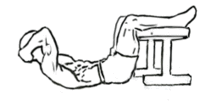- Crunch (exercise)
-
The crunch is one of the most common abdominal exercises. It primarily works the rectus abdominis muscle.
Contents
Form
A crunch begins with lying face up on the floor with knees bent. The movement begins by curling the shoulders towards the pelvis. The hands can be behind or beside the neck or crossed over the chest. Injury can be caused by pushing against the head or neck with the hands.
Alternatives
Crunch exercises may be performed on exercise balls. Weights may be used, typically held under the chin, to increase resistance. Increasing the distance will also increase the load on the abdominals due to leverage.
The curl-up is taught by spine biomechanics professor Dr. Stuart McGill,[1] and he considers it to be a safer alternative to the crunch, which differs from the sit-up.[2] Dr. Stuart McGill has done extensive research on the effects of crunch exercises on the back, which can be especially harmful for those rehabilitating their backs from an injury.[3]
The New York Times Health blog referencing Dr. McGill in 2009 stated:
An approved crunch begins with you lying down, one knee bent, and hands positioned beneath your lower back for support. “Do not hollow your stomach or press your back against the floor,” McGill says. Gently lift your head and shoulders, hold briefly and relax back down.[1]
Strength exercises such as sit-ups and crunches do not cause the spot reduction of fat. Achieving "six pack abs" requires both abdominal muscle hypertrophy training and fat loss over the abdomen -— which can only be done by losing fat from the body as a whole.
Differences between a crunch and a sit-up
Unlike the sit-up, in a proper crunch, the lower back stays on the floor. This is said[citation needed] to eliminate any involvement by the hip flexors, and make the crunch an effective isolation exercise for the abdominals. This is not true, because the psoas muscles are both hip flexors and trunk flexors, and works as a synergist to aid the rectus abdominis in the crunch.
In many cases, the hips will be pre-flexed to shorten the psoas muscles to lessen its involvement due to over-active insufficiency.
The difficulty of the crunch can be increased by lying on a declined bench and/or holding a weight on the chest or behind the head.
Variations
- The reverse crunch is a crunch done with the upper back on the floor and lifting the hips up instead.
- The twisting crunch is performed by lifting one shoulder at a time. More emphasis is placed on the obliques.
-
- The bicycle crunch is a variation of the twisting crunch performed by bringing together alternating elbows and knees, resulting in a leg motion similar to pedaling a bicycle. The bicycle crunch is the most effective in targeting the rectus abdominis and the obliques, according to a study done by the American Council on Exercise.
- The Thai crunch is performed by hitting the stomach after full contraction. This variation is used by Muay Thai fighters to condition the core to take hits from punches or knees.
- The cable crunch is performed while kneeling upright by curling the body to pull down on a cable machine. The hips are kept motionless.
- The dragon flag (thought by some to have been created by Bruce Lee) or simple "flag" popularized by Sylvester Stallone in his movie Rocky IV), called "dragon" after one of Bruce Lee's nicknames, "little dragon". Begin lying horizontal on a bench. The arms are used to hold the underside of the bench to anchor the shoulders to it to prevent rolling forward. The rest of the body inferior to the scapulae is then pulled from the bench. Beginning with legs flexed, the legs can be extended slowly to increase the difficulty of the movement (and tension on the core muscles) due to moving the weight further from the levers. Throughout the movement the knee and hip joints are meant to remain locked in full extension while movement occurs in the abdominal region.[4]
See also
External links
References
- ^ a b REYNOLDS, GRETCHEN (2009/06/17). "Is Your Ab Workout Hurting Your Back?". The New York Times. http://well.blogs.nytimes.com/2009/06/17/core-myths/. Retrieved 2011.
- ^ McGill, Stuart. Low Back Disorders: Evidence-based Prevention and Rehabilitation. Human Kinetics Publishers. ISBN 978-0736066921.
- ^ 3 worst core exercises for people with low back pain
- ^ Greg Wolbert Doing Bruce Lee Sit Ups, a 2007 YouTube video.
Strength training exercises Quadriceps (front of legs) Hamstrings (back of legs) Deadlift (c) · Leg curl (i)Calves Calf raise (i)Pectorals (chest) Lats and trapezius (upper back) Deltoids (shoulders) Front raise (i) · Handstand push-up (c) · Lateral raise (i) · Military press (c) · Shoulder press (c) · Upright row (c) · Rear delt raise (i)Biceps (front of arms) Biceps curl (i)Triceps (back of arms) Abdomen and obliques (belly) Lower back See also: · Calisthenics · Bodyweight exercise · Weight training (List of exercises) · Bodybuilding · Weightlifting · Gym
Legend: (c) - compound exercise, (i) - isolated exerciseCategories:
Wikimedia Foundation. 2010.




